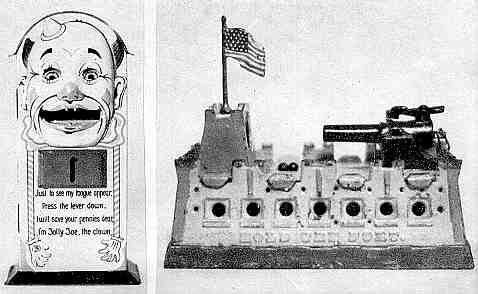Jolly Joe Clown Bank (Tin) and Hold the Fort – Type II
by F.H. Griffith - HOBBIES Magazine - June 1973

Continuing along with the writer’s checking of his files and past articles he has come across two more mechanicals that have no assigned classification number and more importantly have never been fully covered by a regular classification article. This situation should be rectified, of course, so Jolly Joe will be No. 223 in the numerical classification, and No. 224 is Hold The Fort Type II.
At the time of the discovery of the first known example of the Jolly Joe, an announcement of the fact was made in HOBBIES, July, 1968 article, titled "Mechanical Bank Ramblings." Certain details of the bank were covered in a somewhat brief form in this article and mention was made that a regular classification article would appear on the bank at some future date. So to properly complete our information, we show in Figure 1 an unusually fine example of Jolly Joe in extra nice original condition. Colors of the bank are as follows: The curved top is red and the flanged base is black. The clown’s face, a separate stamping fastened to the front, is white with red nose, lips, and marks on cheeks. He has blue highlighting around his eyes, chin, and peaked hat. His eyes are tan with black pupils. His eyebrows are black and various other lines on his face are in black and tan. He has a large red tongue which receives the coin. Tufts of his hair are brown with black lines, his collar is red, white and blue, and his thin hanging arms are like a striped candy or barber pole in red and white. Gloves are white with blue highlighting. "Made In Germany," and the double S appears on his right glove. Underneath the clown’s chin there is a raised red rectangular piece, another separate stamping, that contains the operating lever. Under this appears the following verse in black letters:
"Just to see my tongue appear,
Press the lever down.
I will save your pennies dear,
I’m Jolly Joe, the clown."
All coloring of the front is on a yellow background, as is the coloring on the sides and back. Each side has red and black triangular markings. The back of the bank has a scene wherein a clown is riding a large pig. The clown, standing on his hands, balances a ladder on his feet and at the top of the ladder there is another clown balancing on his hands. In the background are people seated in circus-like fashion and two pennants on their respective poles fly over the heads of the audience. This scene on the back is in various colors of red, black, brown, white, blue, and yellow. To repeat, this coloring is on a yellow background.
All these bright colors and decorations make for a very attractive bank and, of course, the subject matter of a clown is most desirable. So this bank makes a great addition to the clown group of the mechanicals.
To operate, the lever is pressed down. This causes his large red tongue to protrude from his mouth and his eyes to close. Place a coin on his tongue and raise the lever — his tongue recedes with the coin dropping inside and his eyes open. Reasonably simple, but good action.
There would seem to be no question but that this bank is related to the Minstrel (Tin), Scotchman (Tin), Mickey Mouse (Tin), and possibly several others such as the Monkey And Parrot (Tin), all of German manufacture. The time period of the Jolly Joe is circa late 1920’ – early 1930’s.
* * * *
Hold The Fort Type II shown Figure 2 is most easily identified by the seven holes along the front and back sides. Hold The Fort Type I has five holes, (see HOBBIES, March, 1957 article, covering this bank.) There are, however, many other differences between the two banks other than the number of holes. The entire fortress base of Type II, for example, is a completely different casting and the name "Hold The Fort" appears on the front as shown in the photo.
The Type II shown is in unusually fine original condition, no repairs of any kind, and very nice paint. As to colors, the overall fort is a light tan with the four corners in red. The base is blue and the other parts of the fort, such as the turrets, are in red and blue. The cannon is black with a red-tipped firing lever and the target section is red. The appropriately painted American flag on top of the target housing is not original. As a matter of fact, the writer has as yet never seen an original flag for this bank. So, based on what we have to go on, the flag used on the pictured Type II is entirely appropriate and in keeping with the bank. We know, for example, that an American flag was originally furnished with both Type I and Type II, along with a few shot and caps.
To operate the bank, the cannon is first cocked for firing. A pellet or shot is then put in the end of the barrel. Behind the target there is a provided section to hold a coin and one is placed there. On pressing the trigger the shot fires from the cannon, goes through the center hole in the target and hits the coin knocking it into the base of the bank. Real good action and an interesting, attractive bank. For more realism, the bank was made so that a paper cap could be used in connection with firing the cannon. This, today, is not recommended procedure, however.
The underside of the base has the following cast in large raised capital letters: "Clark’s, Patent, Nov. 20, ’77." This with direct reference to the patent papers issued to Samuel Clark of Brooklyn, N.Y., November 20, 1877.
